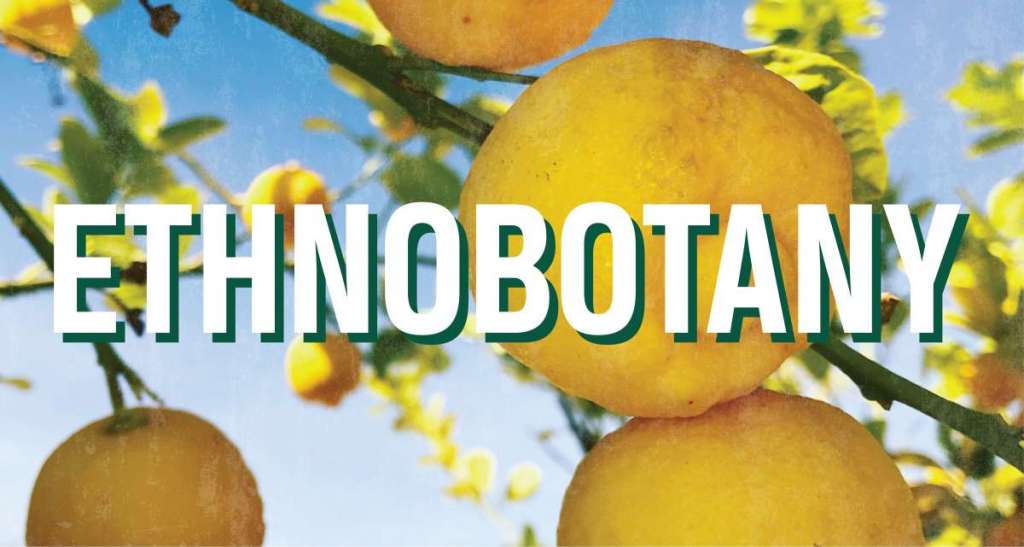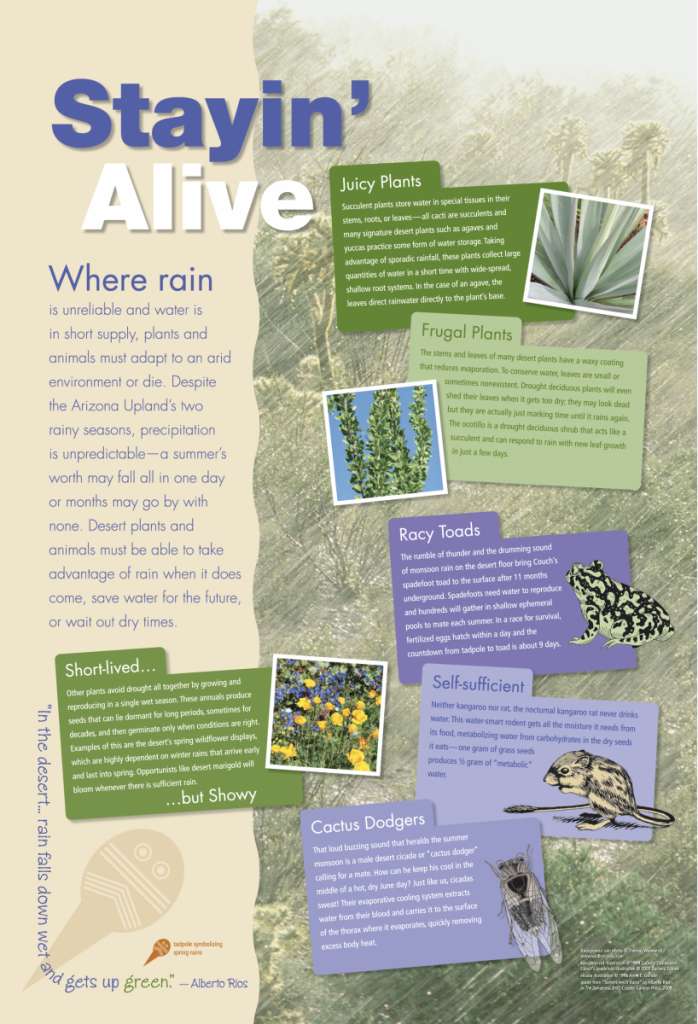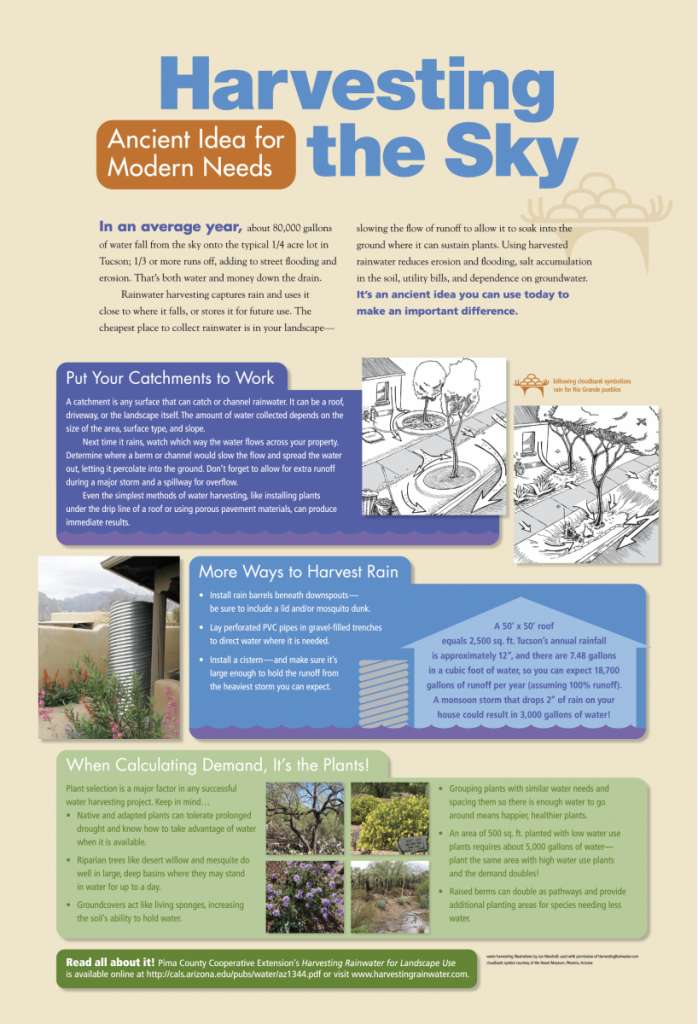Although the earth is wide, the clouds are braced across it and will come…
They will leave the earth soaked everywhere, even the highest hills.
The water will gently flood the little washes, wherever they are…
It will leave the earth well moistened.
After that various kinds of seed will sprout.
— Tohono O’odham rain speech
Day 1 – What is Monsoon?
Let’s Learn More From Our Interpretive Signage, click on the image to learn more
An Arizona Weather Authority Special
Monsoon Special
Monsoons of the Sonoran Desert
Mike Olbinski
Activity Time
Monsoon Worksheets
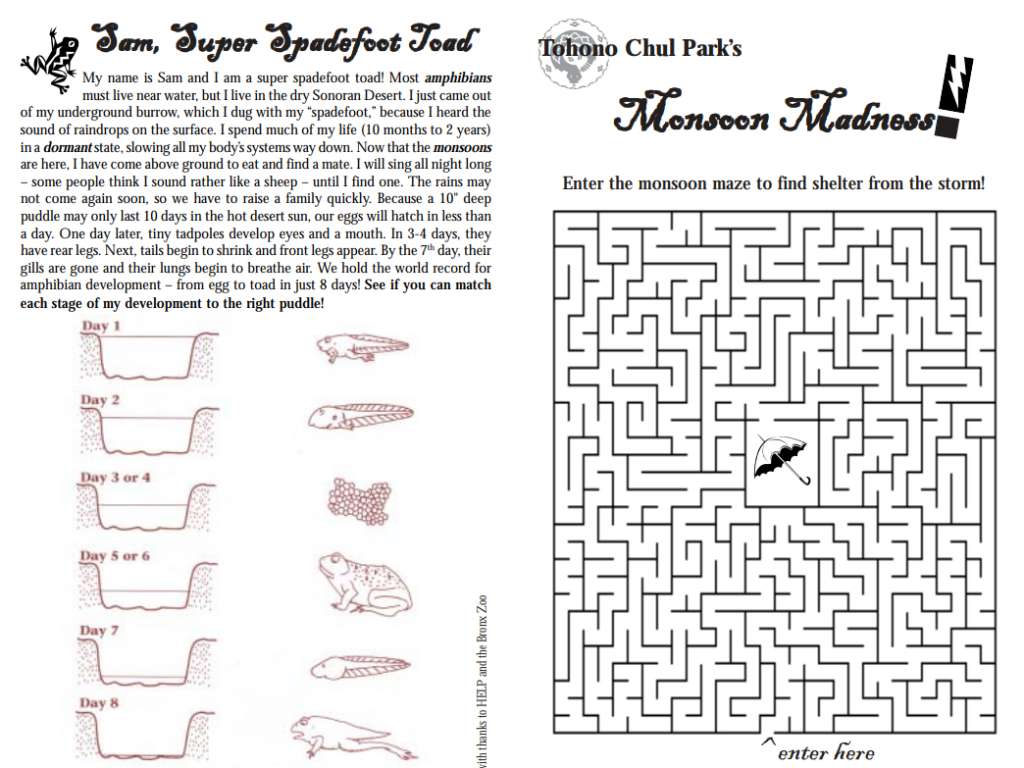
PLAY | 5 Weather Science Experiments
PLAY | 3 Awesome ICE Activities!
Day 2 – Monsoon Gardening
Getting Started, click on the image to learn more
The Rain
by
William Henry Davies
I hear leaves drinking rain;
I hear rich leaves on top
Giving the poor beneath
Drop after drop;
‘Tis a sweet noise to hear
These green leaves drinking near.
And when the Sun comes out,
After this Rain shall stop,
A wondrous Light will fill
Each dark, round drop;
I hope the Sun shines bright;
‘Twill be a lovely sight.
Get Gardening
Native Seeds/SEARCH – ABCs of Monsoon Planting
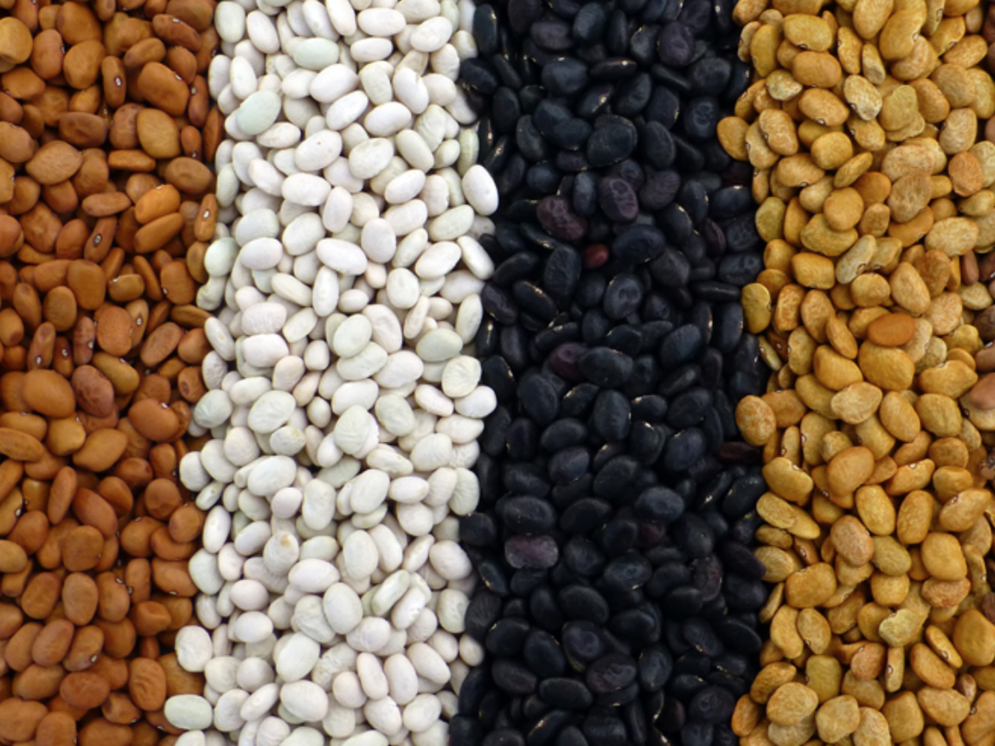
Gardening in the Desert – Planting a Monsoon Garden

Monsoon Gardening Tips Summer Desert Garden
Planting seeds for Monsoon Season In AZ
Rainwater Harvesting
The University of Arizona Cooperative Extension
College of Agriculture and Life Sciences

Planting the Rain to Grow Abundance | Brad Lancaster | TEDxTucson
Brad is the author of the award-winning books Rainwater Harvesting for Drylands and Beyond, www.HarvestingRainwater.com, and co-founder of DesertHarvesters.org. Brad is also a regenerative systems educator, designer, and consultant. In the Sonoran Desert, with just 11 inches of annual rainfall, he and his brother harvest about 100,000 gallons of rainwater a year on an eighth-acre urban lot and adjoining right-of-way.
Rainwater Harvesting – Home System Tour
Rainwater Harvesting QA – Cost, is it Illegal, how I treat, etc,.
Monsoon Blooms
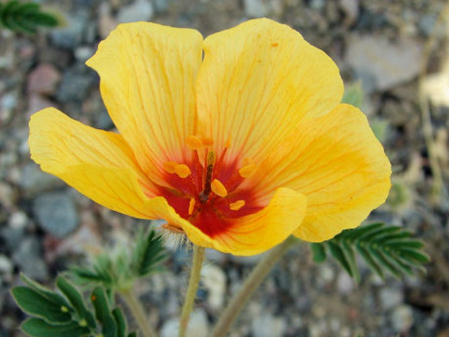
Summer rains mean summer wildflowers like Arizona Poppy (Kallstroemia grandiflora) which will soon be popping up in sandy grasslands and along roadsides. Bright orangish-yellow with a reddish-orange basal spot in the center, the flowers resemble Mexican gold poppies and despite a lack of fragrance, attract a wide variety of pollinators. Its Spanish name is mal de ojos or “sore eyes” because some find the pollen irritating.
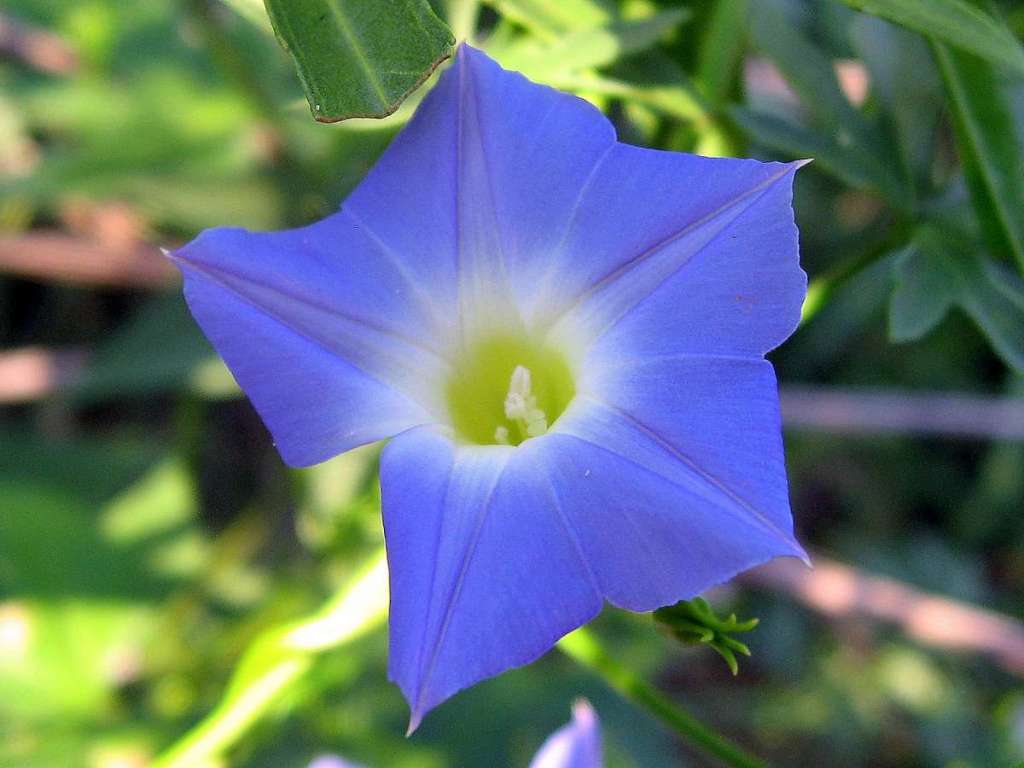
Preferring slightly higher elevations than the desert floor, Canyon Morning Glory (Ipomea barbatisepala) sprawls over rocks and other plants. Its slender vine and palmate leaves (shaped like a hand) give it a delicate appearance further enhanced by small trumpet-shaped bluish to pinkish-purple flowers. Though native, in Arizona it is listed as a noxious weed. What do you think?
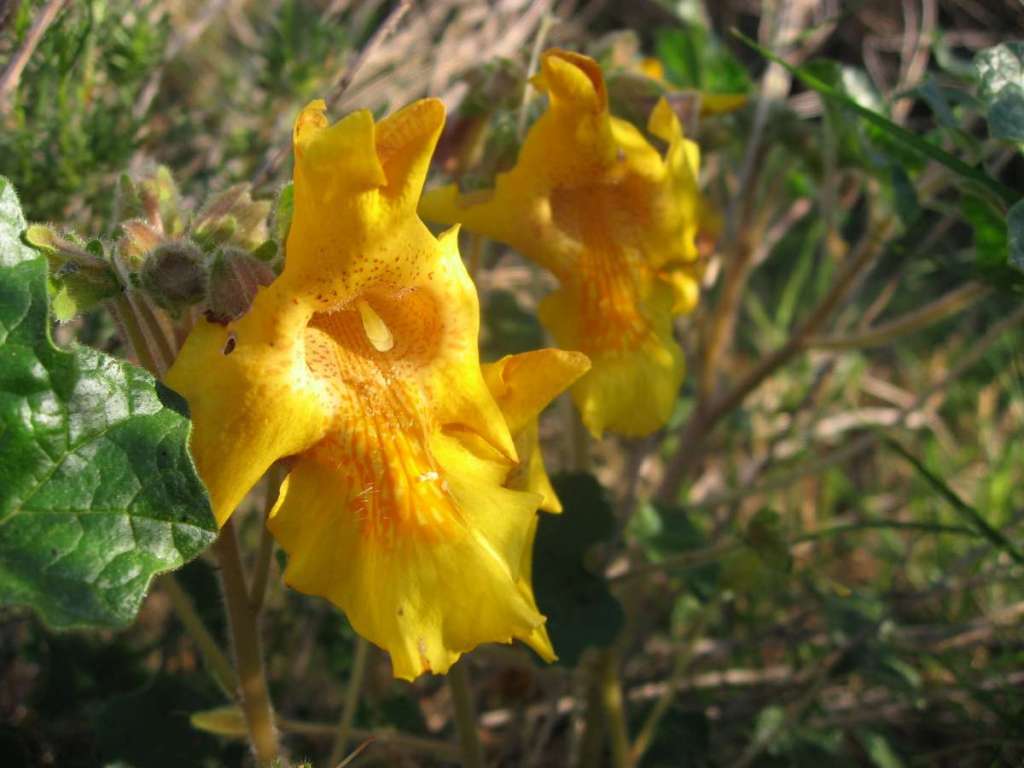
Most remarkable about Devil’s Claw (Proboscidea althaeifolia) is its singular seed pod – a curved horn that splits into two claws as it dries. Growing from an underground tuber, the hairy, sticky stems and leaves are complemented by bell-shaped yellow flowers. Another Arizona species, P. parviflora var. hohokamiania was developed by the O’odham to produce larger seed pods for use in basketry; its flowers are white.
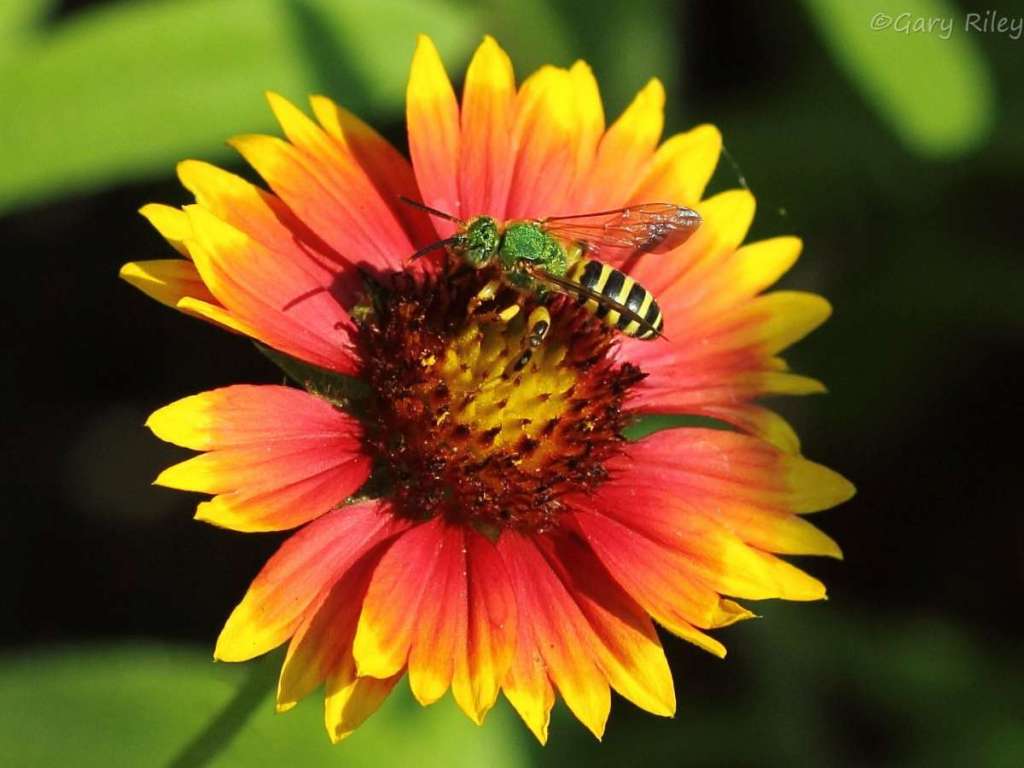
Aka Indian Blanket, aka Firewheel, Gaillardia pulchella is a popular annual for summer gardens but its native habitats are the windswept grasslands and dry plains of the West and Southwest. Its showy flowers are unmistakable – 1” to 2” across, the rays are red, tipped with yellow and each with three “teeth” at the wide end. The disc flowers in the center are brownish-red.
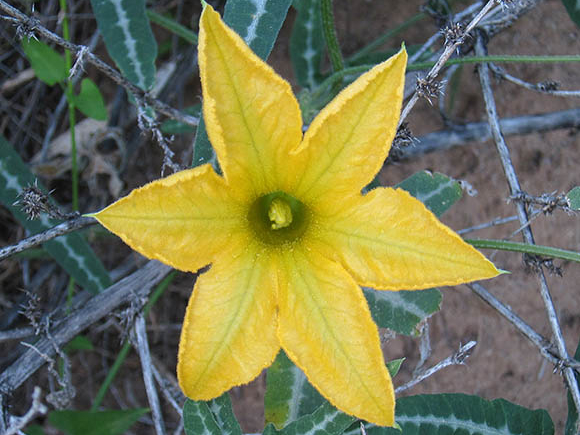
Cucurbita digitata, better known by its common name of Coyote Gourd vines relatively inconspicuously across the desert floor and sometimes along a fence, revealing itself with large yellow “squash” flowers. Pollinated by specialized squash bees, the resulting melon-shaped fruits are striped and mottled green, turning yellow as they ripen. Though bitter tasting, the seeds are edible and dried shells are used as containers.
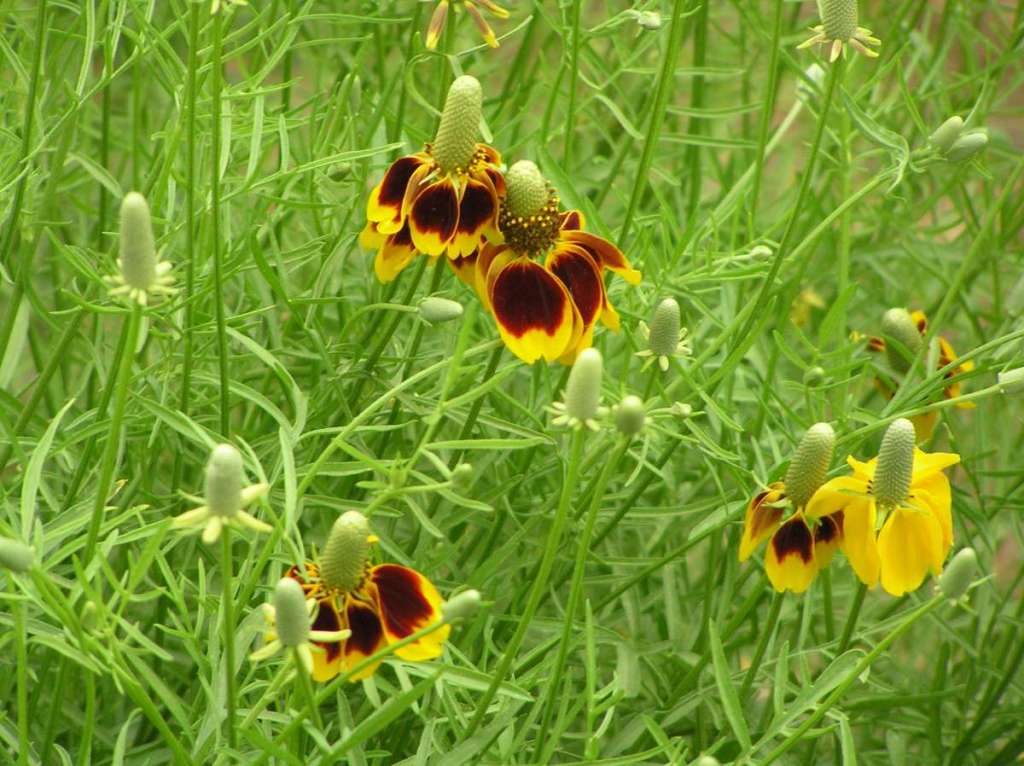
Mexican Hat (Ratibida columnifera) is a fast-growing wildflower, not fussy about where you plant it. Named for their sombrero-look, the leafless stalks bear a single flower head composed of drooping rays in shades of dark red and yellow, all red or all yellow, surrounding a central brown disc that sticks up 1” or more above the petals. Heat tolerant and drought-resistant, the flowers provide for a mix of butterflies and bees.
Activity Time
DIY | Sun Catchers
DIY | Kaleidoscope
Suncatchers Using Old CDS
Day 3 – Artistic Expression

Download this week’s coloring sheets dedicated to the Monsoons!
Get To Know The Artists
Quanita and Jack Kalestewa

Fetish Bowl
The stepped edges of this bowl represent rainclouds with frogs and tadpoles that are associated with rain. Husband and wife duo, Quanita and Jack Kalestewa, began by making jewelry. They later turned to pottery because of the high price of silver, as well has health concerns
More
over breathing the dust from grinding shells. They collect their clay at Nutria Mesa. Their red paint is made from yellow ochre or limonite, and they form their pottery in a trailer behind their home. The Kalestewa family continues to fire their pots traditionally with sheep manure outdoors. They also are known for making very thin-walled pottery.
Michael Chiago

Monsoon Rain Storm
As a result of a successful wine ceremony, the summer rain arrives and washes through the desert. The sky is dark, lightning flashes, and animals seek cover. The monsoon season provides young and mature saguaros an opportunity to replenish their stores of water.
More
Michael Chiago was born on the Tohono O’odham reservation west of Tucson. Set against a backdrop of mountains and desert, his artworks depict the traditional gatherings that bring his people together in friendship and prayer. Chiago illustrated the children’s book, Sing Down the Rain, which tells the story of the saguaro wine ceremony. These paintings are part of a series commissioned by Tohono Chul for our Saguaro Discovery Trail that explores the importance of the saguaro for the Tohono O’odham people.
View the Season of the Saguaro exhibition on the Tohono Chul website, https://tohonochul.org/galleries/permanent-collection/
Annie Gordon
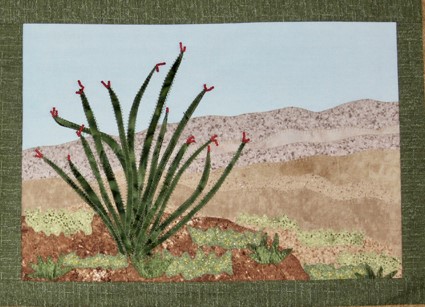
Ocotillo: After
“The Ocotillo in its dormant stage is a beautiful cluster of curved and quirky branches that have a stark beauty. They are also one of the most dramatic examples of the effect of any water on desert plants as within seemingly ‘moments’ of rain they sprout petite richly verdant leaves, and then when the
More
blooming season arrives….Oh my!
I remember being taught how to embroider by a friend’s grandmother when I was in 1st grade and love and use embroidery to this day. I am self-taught in many fabric related arts and have taken many classes through the years. In 1981, I earned an MFA in Weaving and Textile Design from the School for American Crafts at RIT in Rochester, NY. For many years, I wove and sold scarves, shawls and jackets.
I moved to Tucson in 1989, and though I no longer weave, I do continue to work with fabrics creating wall art, quilts, clothing and accessories.”
To view more pieces by Annie Gordon, go to https://www.etsy.com/shop/AnnieGFabricArt
Darlene James Nampeyo
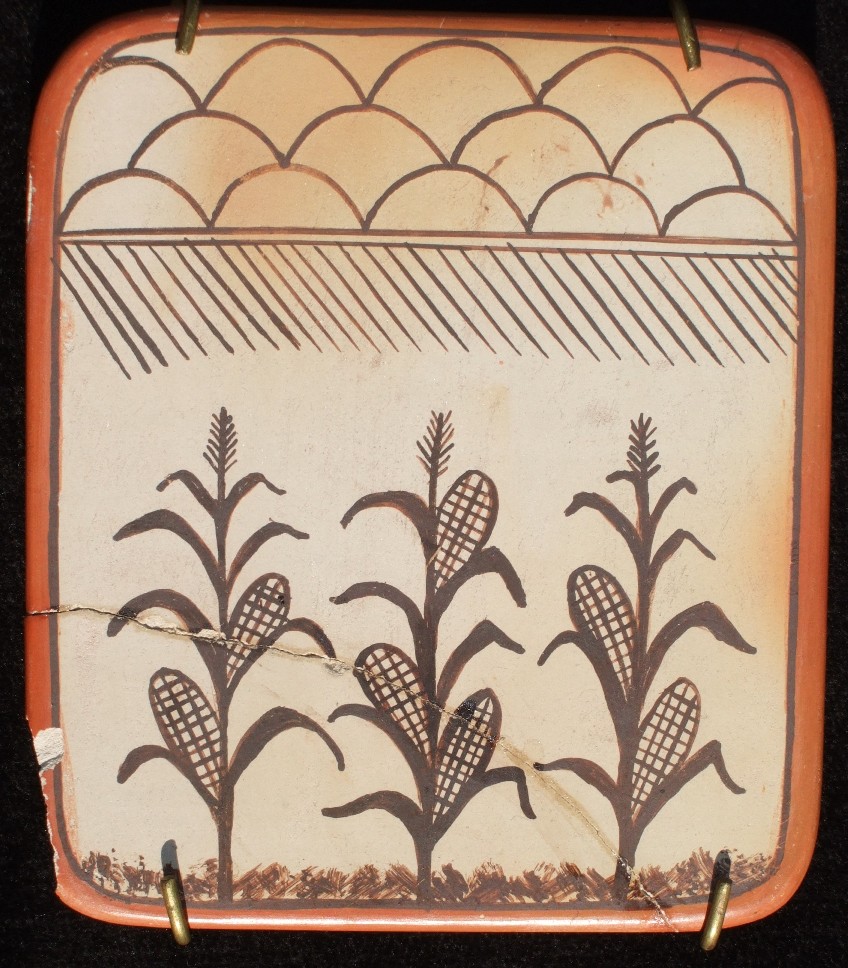
Miniature Tile with Corn and Rain Design
This piece was acquired by Marge and Rit Pfahl at an unknown time before 2006, when it was donated to the Tohono Chul. It is a pottery tile depicting com and rain and was made by the Hopi artist Darlene James Nampeyo, of the prestigious Nampeyo family. Darlene creates pottery by dung-firing her work and decorates it with natural pigments using brushes made from yucca leaves. The brown tones are created with wild spinach. The red comes from mineral hematite.
Hopi tiles are flat pieces of pottery. They are distinctly Hopi. The tradition of making tiles
More
began in the 1880s when trader Thomas Keam, among others, began encouraging Hopi potters to create flat and portable pieces knowing that they would appeal to tourists. A great number were sold in the Fred Harvey shops in the 1920s.
Corn is very important to the Hopi. The first maize, the native name for corn, is thought by scientists to have grown 125 miles southeast of present-day Mexico City about 7,000 years ago. Corn has been depicted in Native American Art since.
Maddie Tsurusaki
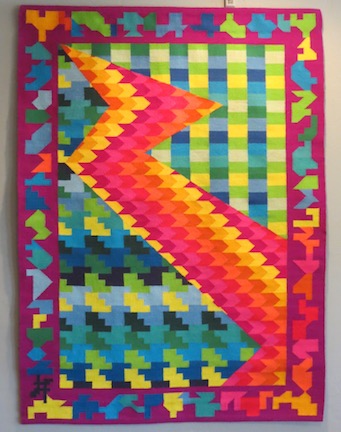
Monsoon
“The Sonoran Desert is blessed with magnificent summer monsoons. In this piece, I used an iconic image of a lightning bolt to play with the colors of the rainbow that follow a storm. The movement and color of shapes in the background suggests the vertical movement of a summer downpour. The border is me playing with shape and color as I weave.
Most of the piece is done in a traditional Swedish tapestry technique called Rolaken. Like any tapestry technique, it can be found around the world under different names.”
More
Maddie Tsurusaki has been weaving for forty years between children, degrees, and traveling. She continues to learn new techniques by attending workshops and studying books. She lives in Tucson.
Trish Hastings-Sargent

Lightning
“My husband and I live in Three Points and our back deck faces the northwest. This is a perfect
More
vantage point to watch the lightning show during Monsoons. We love to sit on our deck and watch the lightning as it crosses the sky. It is so beautiful and so powerful. I have always wondered what is happening on the desert floor during these storms.
I belong to the Tucson Art Quilt Group and we came up with the idea of an Arizona Panel Project to celebrate the Arizona Centennial in 2012. Fourteen individual artists each created their own panel quilt of what they loved most about Arizona. For me it had to be Monsoon lightning. What would be revealed in that moment when lightning strikes and illuminates a desert wash? In my panel is a jackrabbit who suddenly notices he is surrounded by predators!
In creating my art, fiber is my palette. Nothing is off limits. The wider the variety of texture and color, the more dimension is created. I hand dye, paint and add other embellishments to create effects to bring in the viewer.
Raised in the historic New England city of New Bedford, MA, I trained for my artist’s avocation by majoring in graphic arts and photography at Southeastern MA University. After receiving my Bachelor of Fine and Applied Arts, I worked in the studio of a professional Boston photographer, and then spent many years working for a cable television company. After many years I realized how much I missed being creative, so I returned to creating unique art through fabric.
For me, fabric brings both color and texture to a piece of artwork. When you combine fabric with other fiber materials, you have created something that both pleases the eye and invites the viewer to touch as well.
My most recent work is a mixture of photography and fiber art. For three years, I traveled around the country with my husband John obtaining inspiration from the Southwest, the Rocky Mountains and my native New England seashore.
I have displayed my work at many juried fine arts shows around the country. In 2005, John and I settled down here in Tucson. My studio and gallery is located in the Three Points area west of Tucson, AZ.”
To learn more about Trish Hastings-Sargent and her work, visit http://www.ths-studio.com/
Activity Time
Rain Storm Monoprinted Process Art
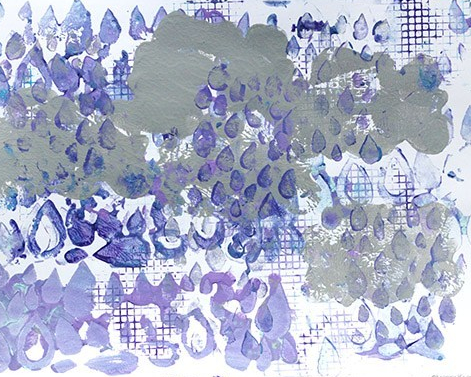
How To Make Raindrop Suncatchers
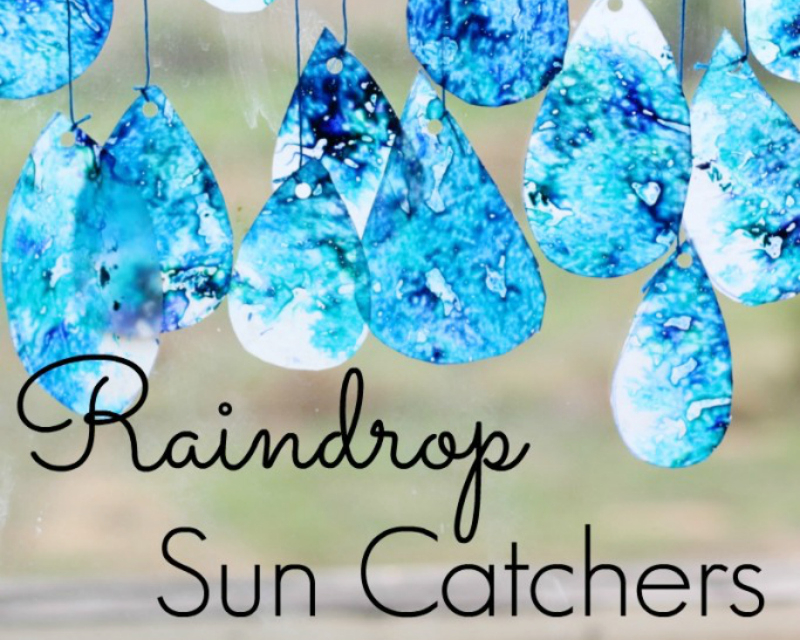
Storm in a Jar
Day 4 – Artistic Interpretation and Featured Artists
A conversation with photographer William Lesch and James Schaub, Tohono Chul Curator of Exhibitions


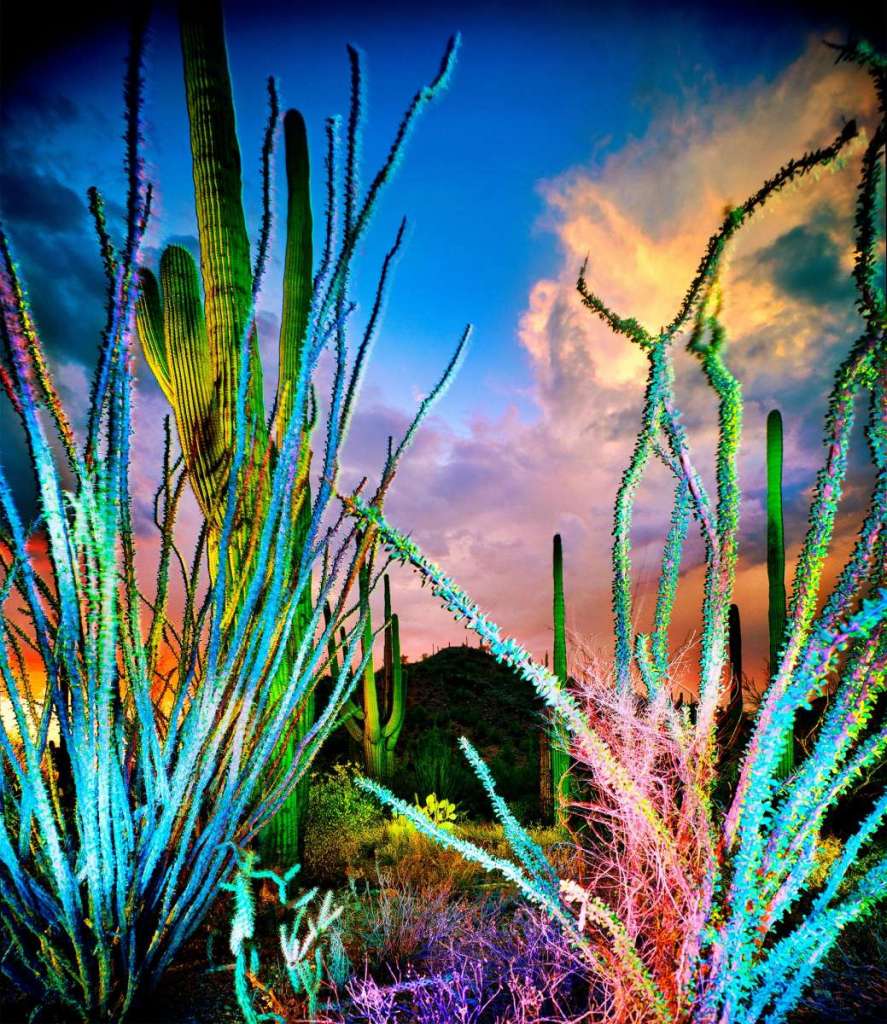
Force and Quietude in an Otherworldly Landscape
Late 1993, I walk into the Scottsdale Civic Center Library for the first time. A few feet inside, up high on the wall is poster with an image of a glowing Blue Saguaro. It grabs me right away and holds me there. The saguaro is electric and following its lead, every other element in the image – including the sky, is reflecting, absorbing, or emitting an odd spiritual aura. Jupiter, falling to the right of the saguaro, hints at the passage of time, yet the time of day in indeterminable. The image is beautifully composed; it is mysterious, mystical, and painterly. Despite how active the jarring incandescent light renders the scene, it also, strangely enough, imparts an engaging serenity I want to bask in – maybe even taking the place of the saguaro, front and center in that timeless welcoming otherworldly landscape.
[expand title=”READ MORE” rel=”fiction”]
I spend a fair amount of time, standing there, looking at it. I know that because, as I turn away, the librarian kindly confirms my interest, telling me – “It does the same thing to me – pretty wonderful! Isn’t it? His book is right over there.” I am directed to the stacks where I find the book William Lesch. EXPANSIONS – (the same image on the poster graces its cover – Blue Saguaro and Jupiter . 1988). I spend my lunch hour looking over the book, I get a library card. The book stays with me for the next month, the image stays with me for the next 27 years, still counting.
That image, that poster, did some very important things. The image introduced me to the work of Tucson based artist William Lesch. I have followed his work ever since; looking forward and getting excited anytime his work is exhibited. The poster encouraged me, new to Arizona, to go to south and see what was going on. I loved what I found in Tucson – the art, the people, the landscape. It is without a doubt one of the most beautiful places I have ever been – it is and has been home for almost 25 years.
For the past 45 years Tucson and Lesch have grown together. I can’t imagine that there is anyone around Tucson that knows, understands, and appreciates Tucson’s beauty better than Lesch. Calling Tucson home since the mid-seventies, the place has been a major factor in the development of Lesch’s distinctive aesthetic and skill set. An encyclopedic knowledge of photography – its history, science, techniques, and processes – pushes him through every trailblazing twist in turn he creates – on purpose or by accident.
For the past five years, it has been my great fortune to get to know him personally, working with him on numerous projects at Tohono Chul. With each project, I know him better as a person and as an artist; I am better because of it. I am always interested in seeing what he is making, hearing him speak, reading his words, and thinking about his work – his energy and enthusiasm have no limit. He is into it, in total, he misses nothing. Lesch is never idle, he is always moving, shifting gears; exploring new materials, ideas, techniques, equipment, technology, and subjects.
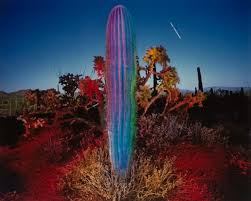


That photograph Blue Saguaro and Jupiter, and the series it was part of, garnered Lesch heaps of praise. That body of work saw him ‘painting with light.’ Those images were created in camera, over long periods of time – exposure on top of exposure; with Lesch moving through the desert night, illuminating elements of the landscape with lights covered with colored gels, all of it burned into film as he left the camera open. He had a good run of it with that series and then, like all great artists, he ran into other subjects, concepts, techniques.
Technology also forced his hand. The equipment and processes employed in photography have changed dramatically over the past two and a half decades, changes that proved difficult at first for those beholden to old-world processes. But, instead of resisting the replacement of his classic equipment and processes, Lesch embraced the advancements and possibilities the new digital equipment and programs offered. He dove in deep.
The transition to the digital realm probably did not affect Lesch the same as it did other photographers because Lesch is never really ‘taking’ a picture – he is ‘MAKING’ an image, creating something that has an otherness to it in terms of concept and intent and an objectness to it in terms of its presence and physicality, whether it be printed on paper or on a distressed and patinated sheet of copper.

The time lapse images that Lesch has been making of the monsoon lightning and thunder storms in and around Tucson are some of the most dynamic still images I have seen of our powerful Monsoon Summer. It is all there: The ominous hush, the roiling clouds, the lightning crackling and tearing through the sky, the low rumble of a distant thunder, the whirling wind of a nearing maelstrom, the exploding tempest flooding into the valley. Setting up on a fixed position, Lesch lets the action come to him – capturing epic storms beginning to end, image after image after image laid upon each other, coalescing under his direction and shaped into a moment that only exists as he creates it.
To make these images he uses equipment and processes that were not even in existence when he was ‘painting with light.’ According to Lesch, they could not be ‘made’ without the digital equipment and programs he is working with. Lesch’s vision, adaptation, and conviction in the creation of his art is beyond impressive – it is truly amazing.
In his person and in his work you will find force and quietude in perfect balance; Lesch’s love of nature and his passion for what he does and how he does it are omnipresent. He understands his work, why he makes it, and what it means in great depth. It is at the confluence of Lesch’s work and words that his brilliance shines. He articulates his thoughts in such a fluid, expansive, heartfelt, eloquent, and intelligent manner that no words other than his can truly stick.

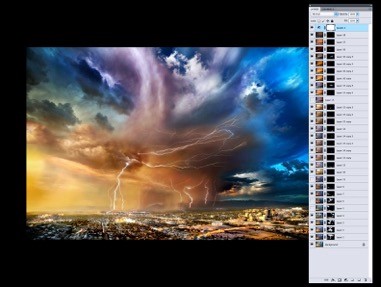
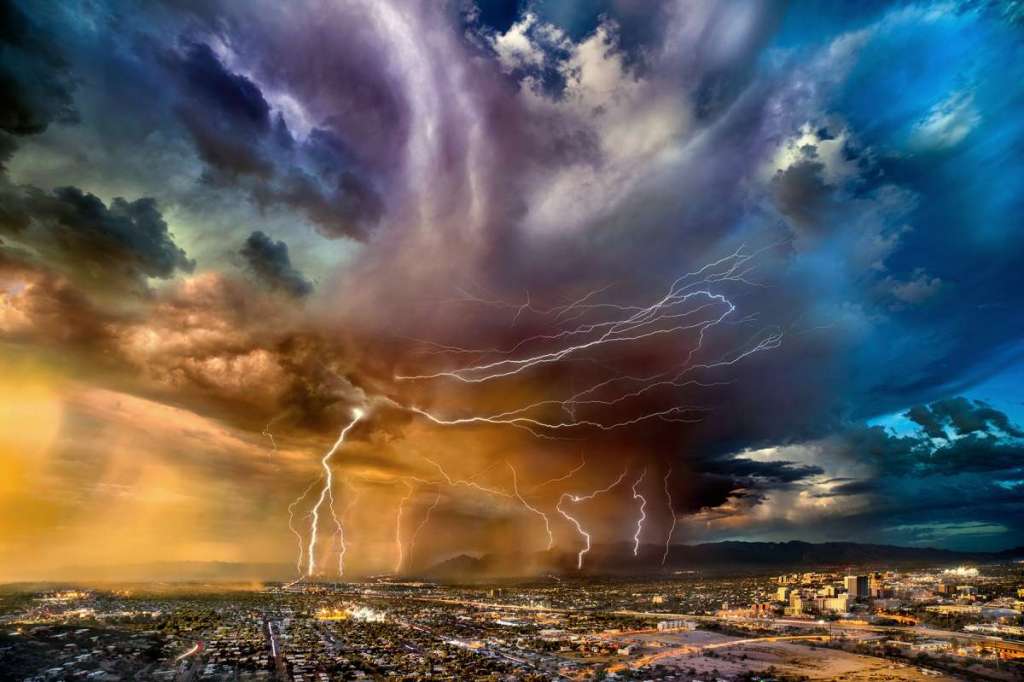
on the Clouds and Time Lapse images:
“The world does not fit neatly into the frame of a single instant, a sixtieth of a second. It is constantly changing, a living thing of which we are but a fleeting part.
I love the breathing wind, flowing water, moving light–the flux of creation. I want to make photographs not of the decisive moment, but of the eternal present. The writer Annie Dillard wrote that “Light has force. The secret to seeing is to sail on solar wind. Hone and spread your spirit till you yourself are a sail, whetted, translucent, broadside to the merest puff.”
I have honed my vision observing the overlapping cycles of this world. I look for the seams, the chinks in the wall of what we think the world looks like. It is in those seams where sight happens, where the world of the ten thousand things, all of which we can name, dissolves into the world we could see before we knew the names.
In that world we could see the symphony of light and movement in which we live, and see music dancing on falling motes of dust flashing in the sun”
STORMCLOUDS: LIFEBLOOD OF THE DESERT
“The summer sky transforms itself from the featureless white-hot blue of June to the twisting, dark energy of July thunderstorms. Native American dwellers of Arizona had elaborate rituals to bring the summer rains for the life-giving waters. I, too, honor the summer rains through ritual photographic homage of the clouds–connecting earth and sky. My philosophy is that the earth and sky are alive. Many cultures and religions found their gods in the skies. Clouds are the spirit of the earth given form. Their cycle of life, forming from nothing and streaming across the sky is indicative of the circulation of the blood of the planet.
I am interested in their movement and flow, in photographing their life force. I open the shutter and the clouds draw themselves, over time. The results continually surprise me. I never know what to expect from a cloud, and for that I give thanks. It is that sense of mystery, of the unknown, that keeps me working”
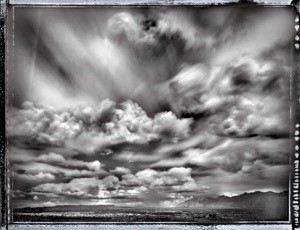


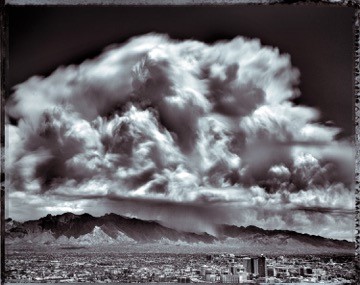

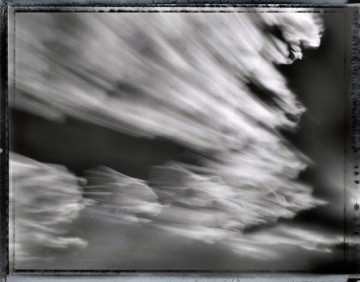
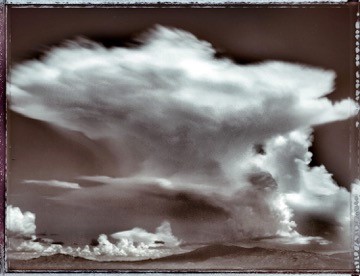


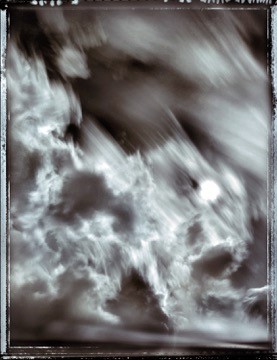
To learn more about WILLIAM LESCH go to: www.williamlesch.com and https://www.williamlesch.com/instagram
About William Lesch
William Lesch was born in Indianapolis, Indiana and grew up in the Midwest. His childhood summers were spent on Lake Wawasee in Northern Indiana and it was at Wawasee that he began forming an intimacy with the natural world. Lesch discovered photography and met his future wife, his two life-long loves, in the same year at the age of 21. He took photography as an elective course while in a pre-med program. Lesch had found his calling, he dropped out of pre-med and switched to art school the following semester.
Lesch earned a BFA in photography from the University of Arizona in 1976. He was the first Staff Photographer at the Center for Creative Photography from 1976-78. It was at this time that he began work on many of his signature series: his first time exposures of clouds, his early color work in the desert, and the beginning of his time lapse light painting series.
Lesch had his first one-person show at the small front gallery in the newly opened Center for Creative Photography in 1976, and since that time, Lesch has shown his work world-wide in over 100 group and one-person shows. He has work in prestigious private, corporate, and museum collections including the Los Angeles County Museum of Art and the Snell and Wilmer Collection. He has received numerous grants and awards and had a book of his photographs published in Japan in the 90’s.
William Lesch still resides in Tucson, Arizona. He lives and works in an adobe house and darkroom that he built himself, by hand, making the adobes in his backyard. Lesch has always felt that life and art are about weaving together complex threads, be those threads colors, light and time, or experiences and skills.
He taught himself to kayak so he could get to some of the remote places where he needed to work, and in 2008 he kayaked the entire 240 miles of the Grand Canyon, and also began work on his current series of Grand Canyon photographs. His youngest son got his pilot’s license in 2001, and the following week Lesch went up in a small plane with him and began work on his series of Aerial photographs of the Arizona landscape.
Lesch is a meticulous craftsman and has always made his own prints, from his years of film and silver prints to the digital darkroom. Photography is the language William Lesch speaks, it is his way of interacting with the world. He finds this world a miraculous place, and photography a means to explore it.
William Lesch has exhibited his work throughout the world – Tohono Chul has featured his work since the 1980’s – exhibitions since 2015 include: THE SKY ABOVE (2015); A(MAZE)ING MAPS AND LEGENDS (2016); SONORAN SYMBIOSIS (2016); DAY FOR NIGHT (2017); ARIZONA ABSTRACT (2017); DESERT CORRIDORS (2017); SONORAN SEASONS (2018); 10 x 10 | A FUNDRAISER (2016 – 2019); ARIZONA OTHERWORLDLY (2018); SONORAN STORIES (2018); WILLIAM LESCH (2018); COPPER STATE (2018); and ON THE DESERT | the Discovery and Invention of Color (2020)
William Lesch begins at 15min. 17sec.

[/expand]
Featured Artists
Janet Marie
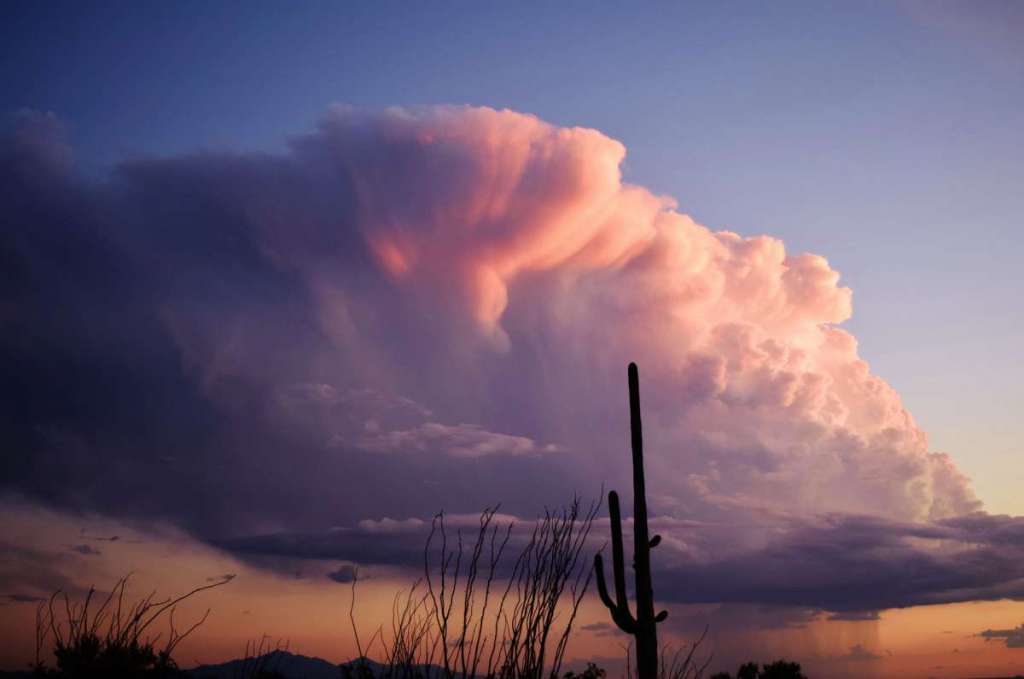
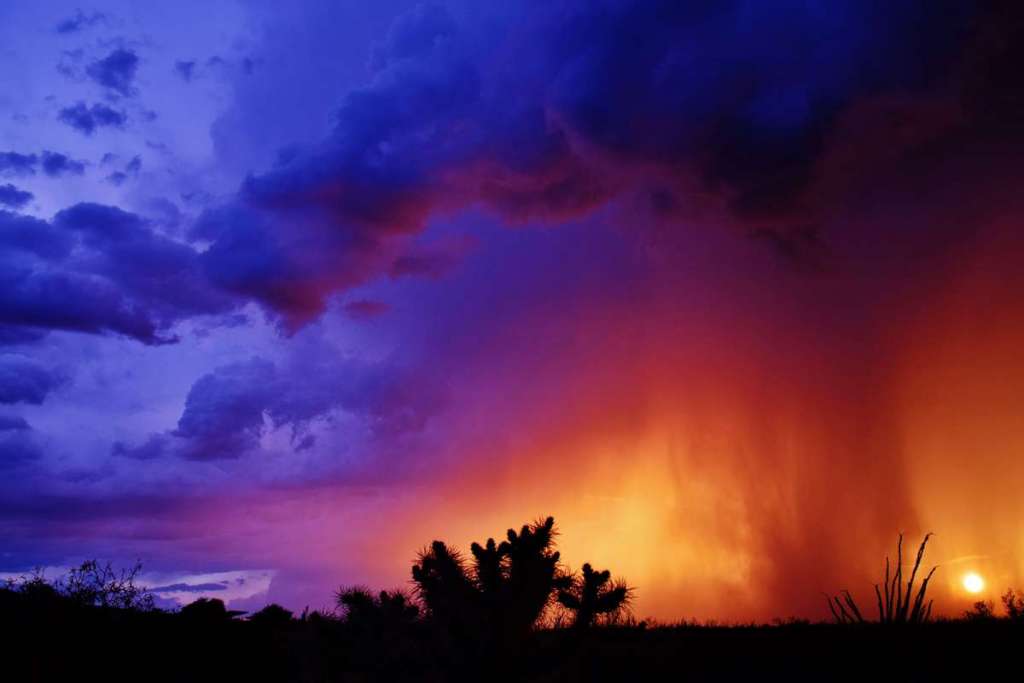
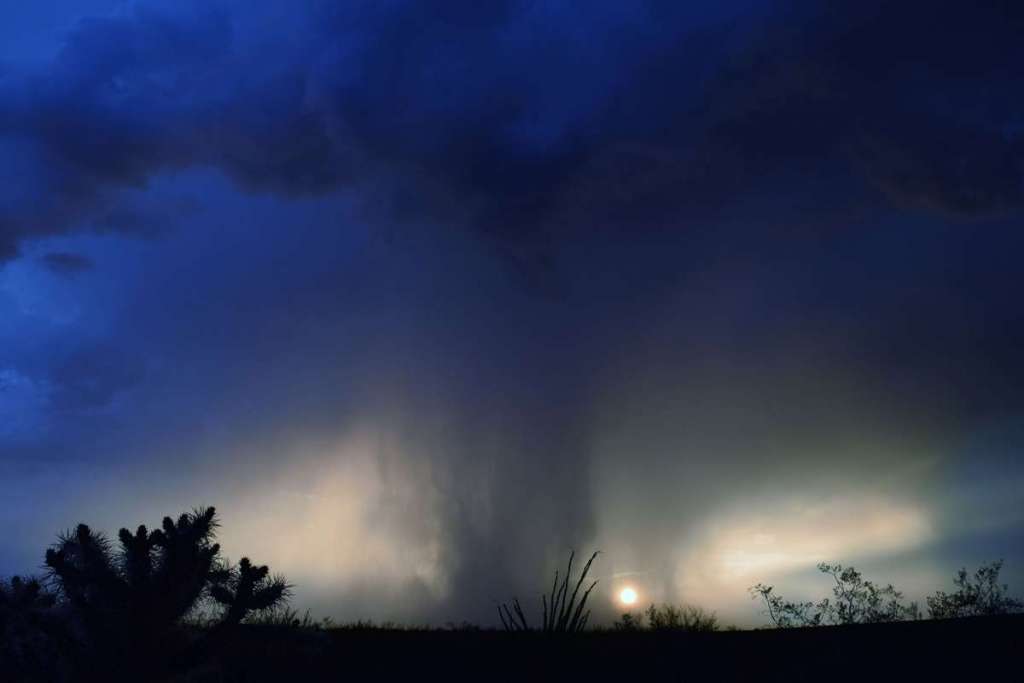
“Part of our fantastic trip in Saguaro National Park, is capturing all the wonders of this unique and fabulous National Park (one of three in Arizona, USA). Of course I am always hoping for sublime cloud, sky, and sunset captures. Here we have at dusk, a glorious, luminescent, dappled, billowy CLOUD, behind a silhouetted Saguaro Cactus and Ocotillos. Adorning the cloud is a lovely, pink corsage. Rising up out of the cloud. Also reminding me of a bridal bouquet. I call this, Corsage Adorned Cloud!”
More
“The Arizona Summer Monsoon season really hit hard in the month of July! This capture was the result of a super storm, moving Eastward in Tucson, Arizona. Unlike anything we had witnessed before. So amazing, to be able to capture the EVER CHANGING, glorious grandeur of this Summer Monsoon storm system at sundown!! It felt a bit like we were going to be featured on The Weather Channel’s ‘Tornado Road!’ Trying to catch that one amazing shot, but I was able to capture more than one great shot. This capture in the series, was like it was raining fire! Reminding me of the song title of Adele’s, “I Set Fire To The Rain!”
“On July 14th 2017, the Northeast Pima County, Tucson, Arizona area was hit with a TORNADO watch from The National Weather Service!! Here is a series of photography, of the results of that storm, moving east. Unlike anything we had witnessed before. So amazing, to be able to capture all the EVER CHANGING, glorious, grandeur of this Summer Monsoon storm system at sundown!! I felt a bit like a ‘storm chaser!’ This capture in the series, really did Take Me By Storm!! The setting SUN looks like someone coming through the storm with a large flashlight! UNBELIEVABLE!”
Nancy Chilton
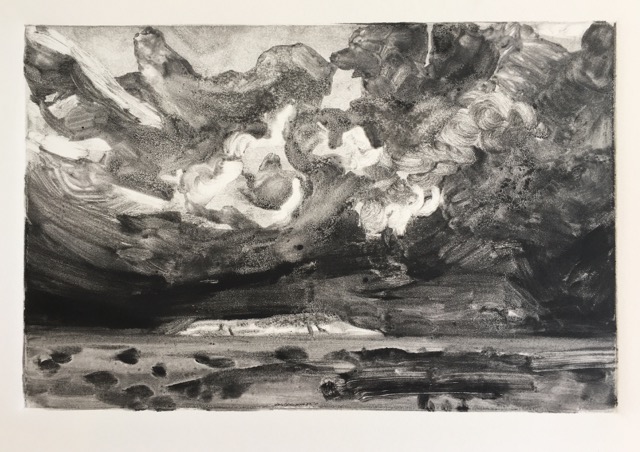


“The season of summer monsoons and the process of monotype share qualities of layering, sequencing, shifting tone, and unpredictability, which creates a ‘perfect storm’ of opportunity for creative work.
More
The process of monotype is direct and intuitive. I begin by applying ink to the plate using rubber rollers. The image arises and shifts as I move ink around using rollers, cloth, and brushes, adding blending fluid to thin the ink and blur edges. Then the plate passes through an etching press. It’s always a surprise to see the work on paper (and reversed) for the first time.
After printing there is a residue of ink left on the plate, called a ‘ghost’. This becomes a starting point for the next piece. Storm: Dissolution results from an inky plate left after I printed Storm: Concentration. Before printing the ghost, I reworked the plate, adding and removing ink with rags, rollers, and brushes. I titled these pieces with the idea of pressure and release that we feel in our bodies as storms arrive, land, and depart.
Storm: Conductive Thread is a ghost image printed over an initial image. I intentionally printed the second image slightly off-register. The title comes from the first line of Etel Adnan’s Premonition: ‘There’s always a conductive thread through space for untenable positions.’”
Christopher Allison
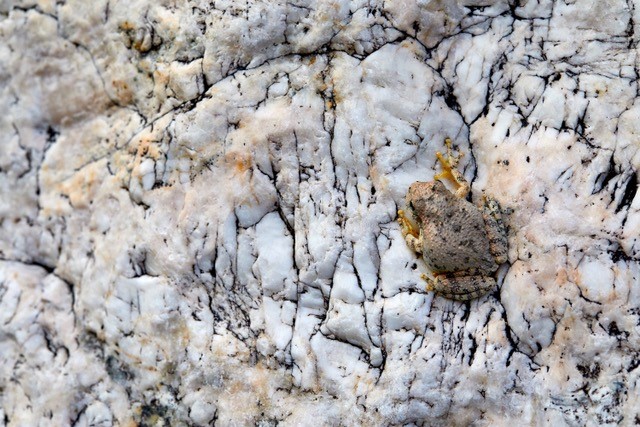
“Arizona’s Monsoons provide the water that is necessary to allow Canyon Tree Frogs to thrive along creeks that are dry throughout much of the year. After the first
More
monsoonal rains, these incredible amphibians congregate along boulders near water. As evening approaches, their chorus begins to rise through the welcome humid air.”
Jerry Bokowski
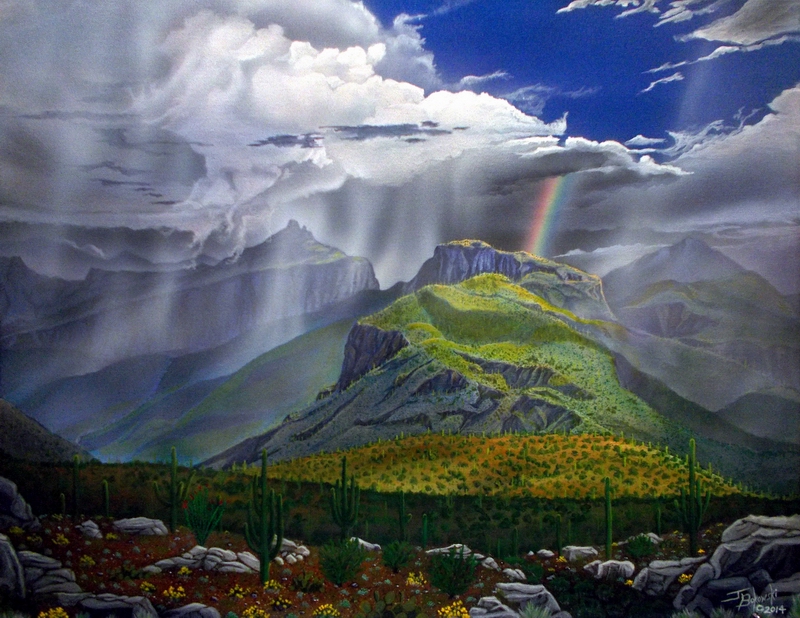
“Sabino Canyon, of the Santa Catalina Mountains, north of Tucson, is a true oasis in the desert. Summer monsoon storms green up the dry land,
More
and wild flowers thrive. Here we see the entrance to Sabino Canyon, just beyond the saguaro studded foothills. Thimble Peak is shrouded by curtains of rain, while the ACROPOLIS WALL that forms the southern boundary of the canyon, is lit by the sun. A rainbow adds to the beauty of the moment. The temperature has dropped almost 30 degrees, while a refreshing breeze is full of the scent of rain and creosote. Add some distant thunder, and you now have a feast for the senses…sight, sound, smell, and touch. I love being up close and personal with mountains and lush saguaro laden deserts of Arizona, especially when they are caressed by weather and light.”
Jerry Cagle

“The earth and the movement of air and light across the surface of the land, exerts a palpable, emotive pull, simultaneously physical and spiritual. The play of the seasons in the
More
Sonoran region stands as a testament to the diverse moods elicited by those emotive elements. The monsoon season, in particular, works a uniquely potent magic; as the light dances across the face of the mountains and the grasslands we are transfixed.
In this work, using photography as the vehicle, I seek to evoke an emotional response that engenders a strong connection between viewer, artist, and place through the use of color and the character of the season.”
Cheryl Fecht
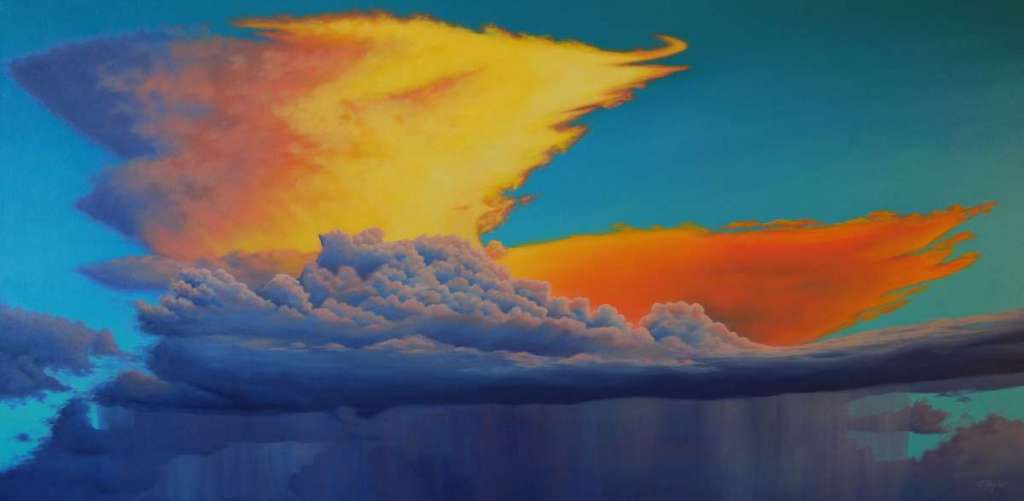
“One cloudy afternoon in August of 2013, I stood outside my home photographing the immense cloud formation above me. This anvil cloud formed before my eyes, rising into the atmosphere some 30,000 feet above me, massive and impressive.
More
Just when I thought it couldn’t get any better, the sun started to go down throwing its glory onto this cloud, and the rain poured down to give the dry desert a long awaited drink of monsoon nourishment. I was able to capture the moment on film to use for this painting.
Arizona has some of the most dramatic skies that I have ever experienced. The colors are unique to the Southwest and so very spectacular. This painting depicts some true Arizona drama in the “Big Skies” that are so well known to this part of the country.
Margit Kagerer
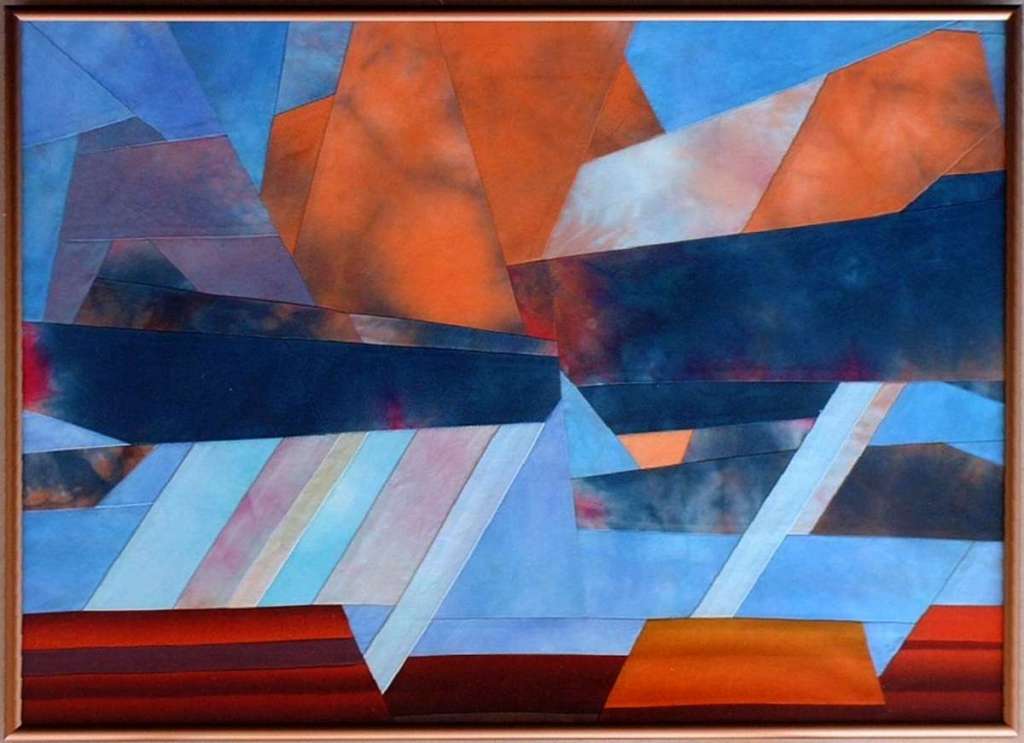
“Before I came to Arizona I thought that the sky in Arizona was always just blue and cloudless. After living here for 17 years I know that the sky shows many shades of blue and has all kinds of clouds.
More
Clouds are moving across the sky like sailing boats. By late afternoon the blue sky turns into shades of pink and purple indicating a possible beautiful sunset.
Those towering clouds of the monsoon; they promise long-awaited rain.”
MaryAnn Ead

“I live in a magnificent place that affords me broad panoramic views of Sonora. I am in love and mesmerized by its beauty every day. The big skies, with amazing form and movement inspire me as
More
I keep my head in the clouds. There is a quality in the landscape that I translate into my art with the quality and romance of texture and color. It gets abstracted, much like the spirited dance of the desert land.”
Steven Paul Tallo

As this painting began, the scale of the saguaros was a vital element to its initial fabrication. A saguaro trunk element was loosely represented within the confines of a square block. Several blocks were stacked to build
More
a complete saguaro. The squares were of various sizes and were described mathematically by a geometric series progression (1/2+1/4+1/8+…) so that each square would have an area equal to ¼ the next largest square. The arrangement of the squares set the conditions for several coincidences of scale and space to occur. An example, probably not found in the painting, follows…
A new growth segment of a saguaro is visible on top of a hillside one mile away. It seems to be nearly half the width of the saguaro trunk that it rests on. Attributes of this growth segment include its scale, form, and color saturation …all coinciding within a context to define the viewer’s interpretation of its apparent position in space. As the viewer changes position, the relative attributes change and the context changes as well. Now, it seems to belong to a completely different saguaro located on a hillside two miles away
Kate Breakey
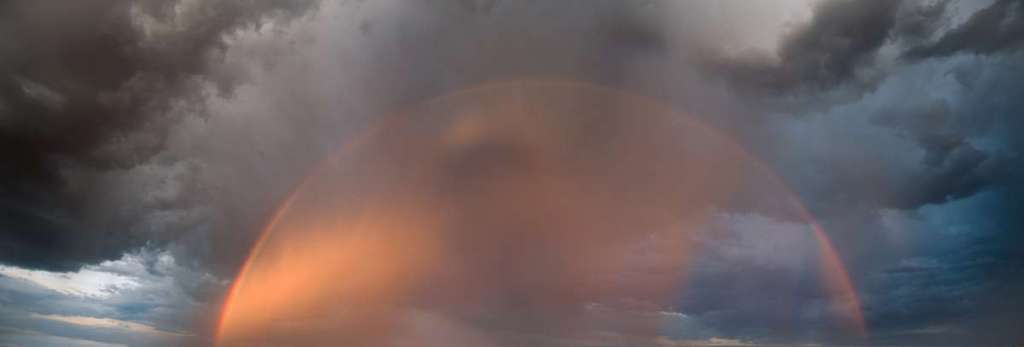
Sunset Rainbow, Tucson is drawn from Breakey’s latest series, Out of Darkness. These deeply felt landscapes are metaphors for dramatic personal events that have recently changed her life.
Peter Kresan


Cloud Over the Ives Lava Flow and Sand Dunes, Southern Pinacate Volcanic Field, Northwest Sonora
“This is a three image vertical panorama, taken along one of the nature walks at the Schuk Toak Visitor Center for the El PinacateGran Desierto Altar Biosphere Reserve and World Heritage Site.”
and Storm Over the San Pedro Valley, Southern Arizona . 1975
“This is a late summer storm as seen from the Route 80 between Tombstone and Bisbee.”
Jeff Smith
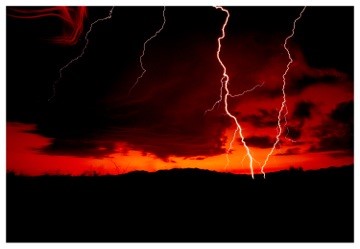

“Growing up in Tucson, on many a summer night, my father and I watched the monsoon storms rolling in over the Santa Catalina Mountains. This amazing, natural energy was breathtaking and exciting. For the past 30 years, I have spent my summer nights in the Arizona desert chasing lightning.
In ‘Bear Canyon Blue’thesilhouette of distant cactus against the darkened summer sky is alluring and seductive.The lightning and cool rain encompass the desert’srelease. In ‘Close Call in Sells, Arizona’ the energy of the sky and earth is before us, acknowledging nature’s magnificent beauty.”
William Lesch
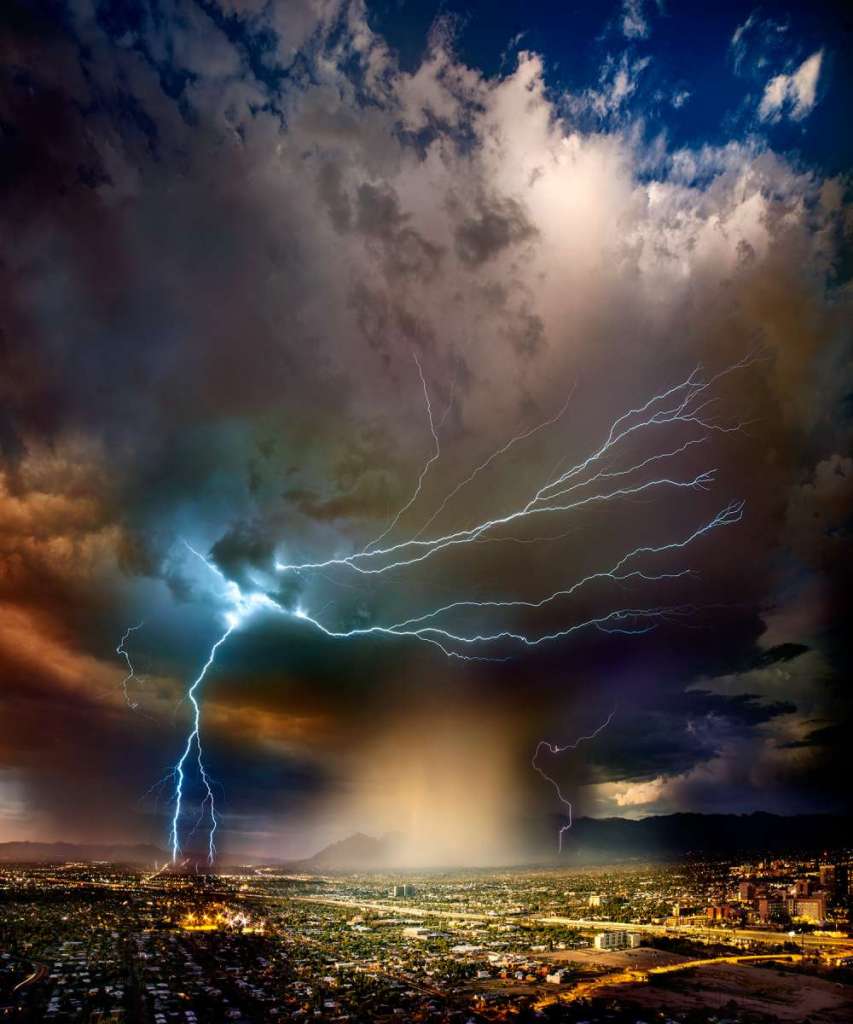
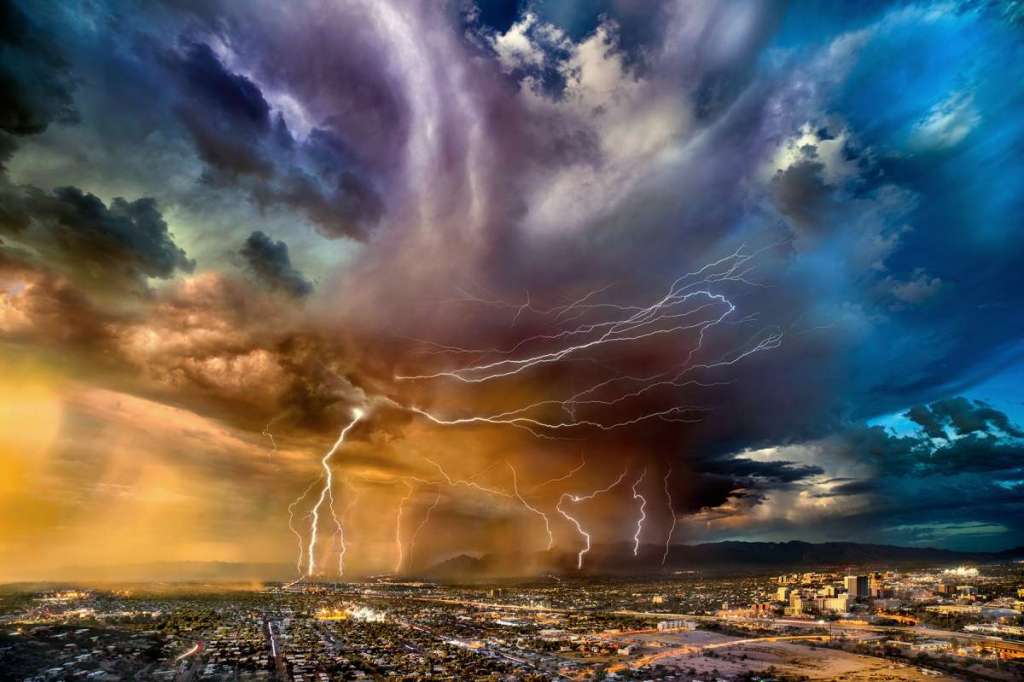
“The world does not fit neatly into the frame of a single instant, a sixtieth of a second. It is constantly changing, a living thing of which we are but a fleeting part.
More
“The world does not fit neatly into the frame of a single instant, a sixtieth of a second. It is constantly changing, a living thing of which we are but a fleeting part.
I love the breathing wind, flowing water, moving light–the flux of creation. I want to make photographs not of the decisive moment, but of the eternal present. The writer Annie Dillard wrote that “Light has force. The secret to seeing is to sail on solar wind. Hone and spread your spirit till you yourself are a sail, whetted, translucent, broadside to the merest puff.”
I have honed my vision observing the overlapping cycles of this world. I look for the seams, the chinks in the wall of what we think the world looks like. It is in those seams where sight happens, where the world of the ten thousand things, all of which we can name, dissolves into the world we could see before we knew the names.
In that world we could see the symphony of light and movement in which we live, and see music dancing on falling motes of dust flashing in the sun”
“STORMCLOUDS: LIFEBLOOD OF THE DESERT
The summer sky transforms itself from the featureless white-hot blue of June to the twisting, dark energy of July thunderstorms. Native American dwellers of Arizona had elaborate rituals to bring the summer rains for the life-giving waters. I, too, honor the summer rains through ritual photographic homage of the clouds–connecting earth and sky. My philosophy is that the earth and sky are alive. Many cultures and religions found their gods in the skies. Clouds are the spirit of the earth given form. Their cycle of life, forming from nothing and streaming across the sky is indicative of the circulation of the blood of the planet.
I am interested in their movement and flow, in photographing their life force. I open the shutter and the clouds draw themselves, over time. The results continually surprise me. I never know what to expect from a cloud, and for that I give thanks. It is that sense of mystery, of the unknown, that keeps me working”
Fran McNamara

When the Sonoran Desert is graced with rain, a uniquely strong aroma dominates the air. The smell is
More
derived from the leaves and crushed seeds of the native Creosote bush. The leaves are coated with chemical resins to prevent water loss, which enhances its resilience to drought and longevity, many bushes can live to one hundred years.
The Creosote has been a much welcomed smell to the people of the desert, conveying a positive message “RAIN”!
Janet Windsor

“The sky darkens, the wind picks up, and then…joyful, soaking rain! Fiber art is my medium. Sewing since I was
More
twelve, I combine my graphic design skills with stitching in my pieces. The textural qualities and reflectivity of fabrics fascinate me. Great depth and richness can be attained through the medium of fabric. I continue to explore the possibilities of stitching, shredding, dying, weaving to convey my impressions of the natural world around me.
Eileen Dudley
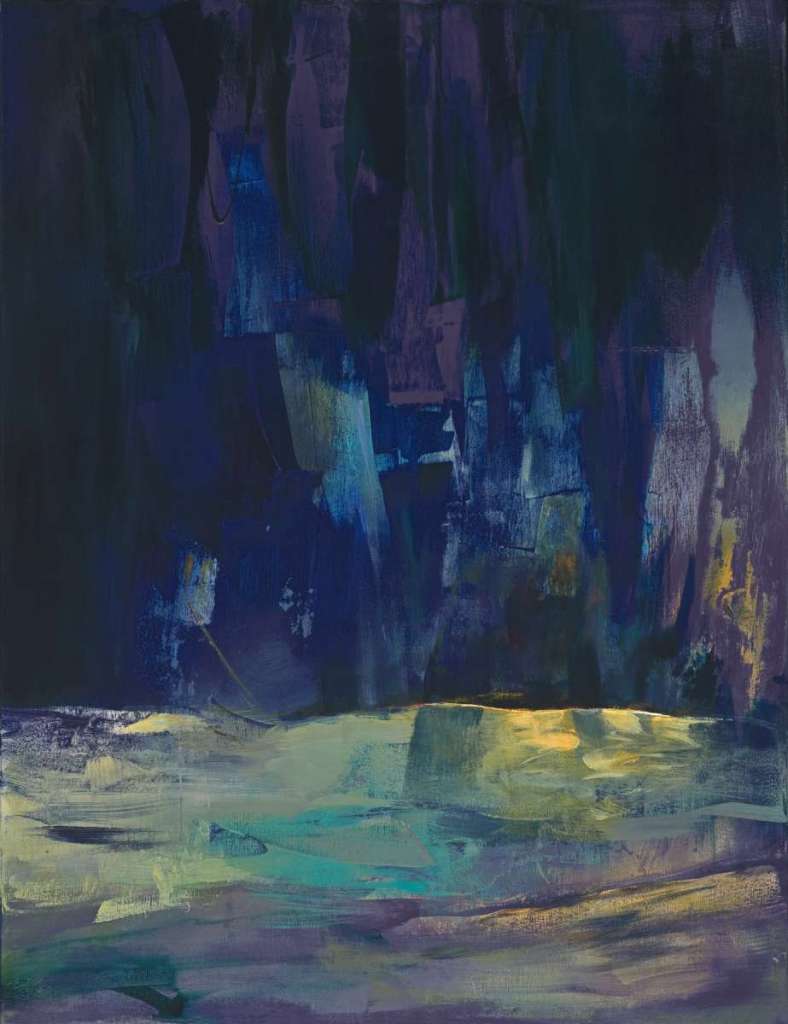
“After exploring southeastern Arizona in hiking boots for 25 years I have appreciated feelings about the place. For me, the best way to express those feelings is to paint them. I have been in the desert in the summer when the baked land shimmers with white heat; in the fall when washes are dry and cottonwood leaves turn yellow; in the winter when the wind is sharp even though the sun is brilliant in a cerulean blue sky; and in the summer when
More
monsoon rains thunder through the valley.
Because I have been there, my memories occupy a strong place in my internal landscape. I let memories ripen in my imagination. Then I paint, but without a plan or an intention. I let the painting suggest over time what it is going to be.
I paint in layers and scrape, revealing what lies beneath. I am never quite sure what is going to be revealed, but it will nearly always be manifestations of the land and the light we which I live.”
Lyle Rayfield

“In designing this piece, I played with putting separate wavy sections of metal clay strips together into a pattern. After many attempts, the present form took shape. I did not yet know its role, so I studied it to see what it had to say…it spoke of landscapes. As I was searching for the content of its layers, I saw a river…and sunshine. And then I thought of the summer monsoons. Combing through my stash of stones, turquoise was the natural choice for the river.
More
Turquoise represents protection, as the rain that fills the dry riverbeds protects and keeps our desert healthy. I chose yellow jade to represent the sun, as, metaphysically, it is known for its properties of being cheerful and energetic. Some of my favorite tiny beach stones filled the final spot, representing the ground. I added a chain that reminded me of a rain chain, a decorative ornament used to soften the force of a monsoon rain and delight the senses with its graceful trickling effect. I love the summer rains!”
In The Making
A Storm in a Jar: 10 Cool Art Installations That Imitate Weather

Arizona Public Media: Shooting Lightening
Day 5 – Weekend Inspiration
Making A Rainstick With Cholla
With crashing thunder and soaking rain, the monsoon season really stirs our senses. You can make an instrument that mimic the sounds of falling rains.
Basic, non-Cholla Versions
Cholla How-To
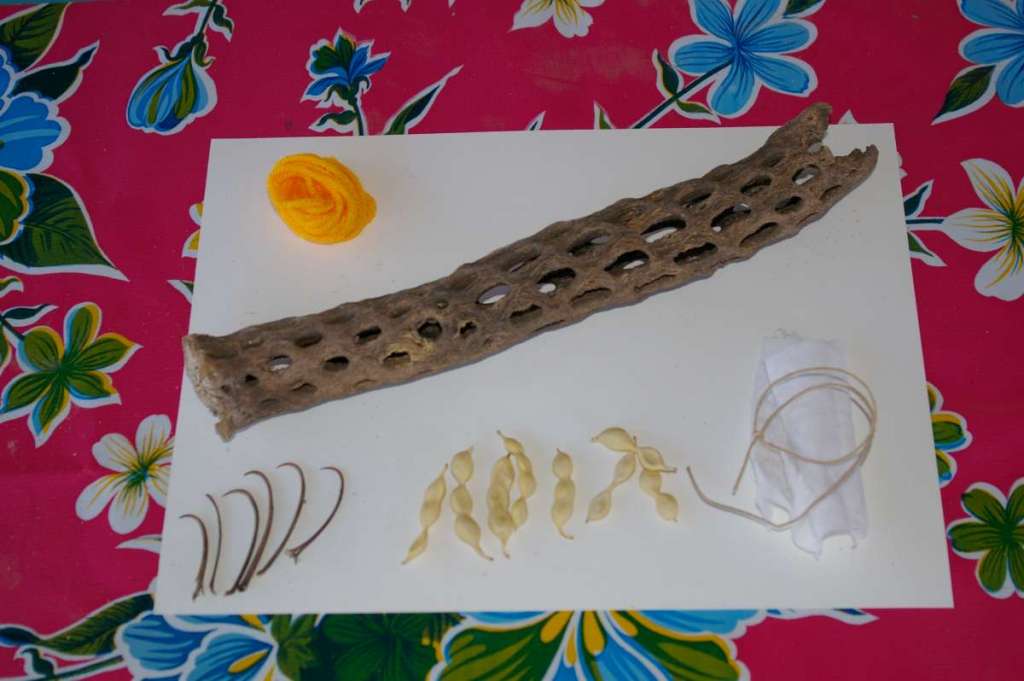

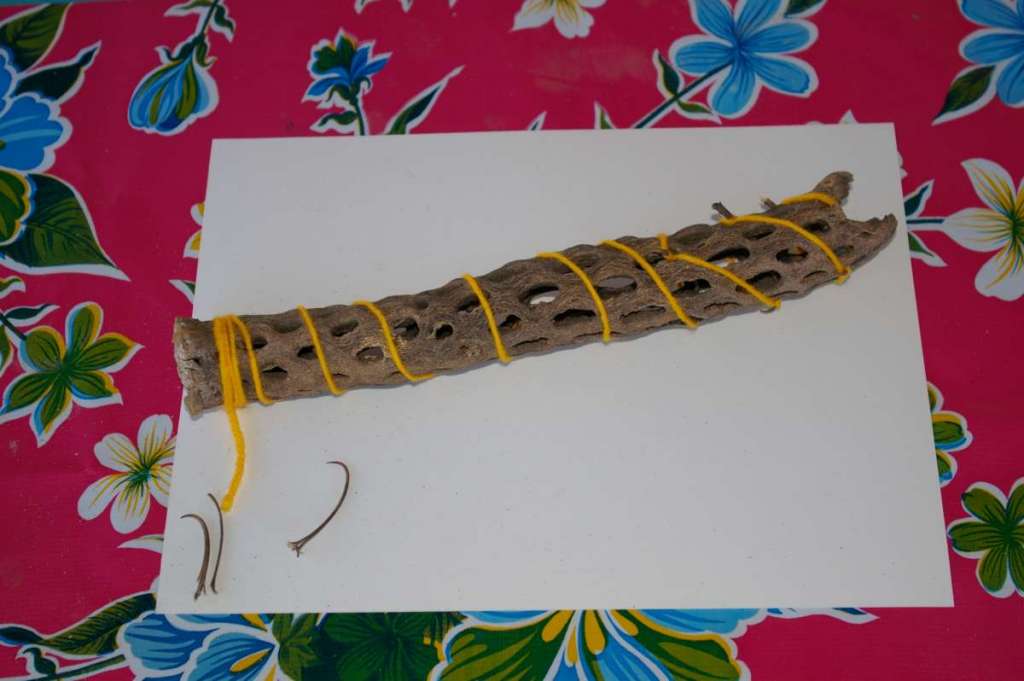

Stephen, Tohono Chul Interpretive Program Manager, decided to use a piece a Cholla skeleton from his backyard for the body, and fishhook barrel cactus spines and small mesquite pods to make the sound. He is using a piece of orange yarn to hold the spines in place, and a white piece of cloth and some twine to close the open end of the rain stick.
First place the spines through the holes of the piece of cholla following a spiral pattern, just like the tutorial shows you how to place nails in a spiral pattern.
Then use the warn to tie the pines in place.
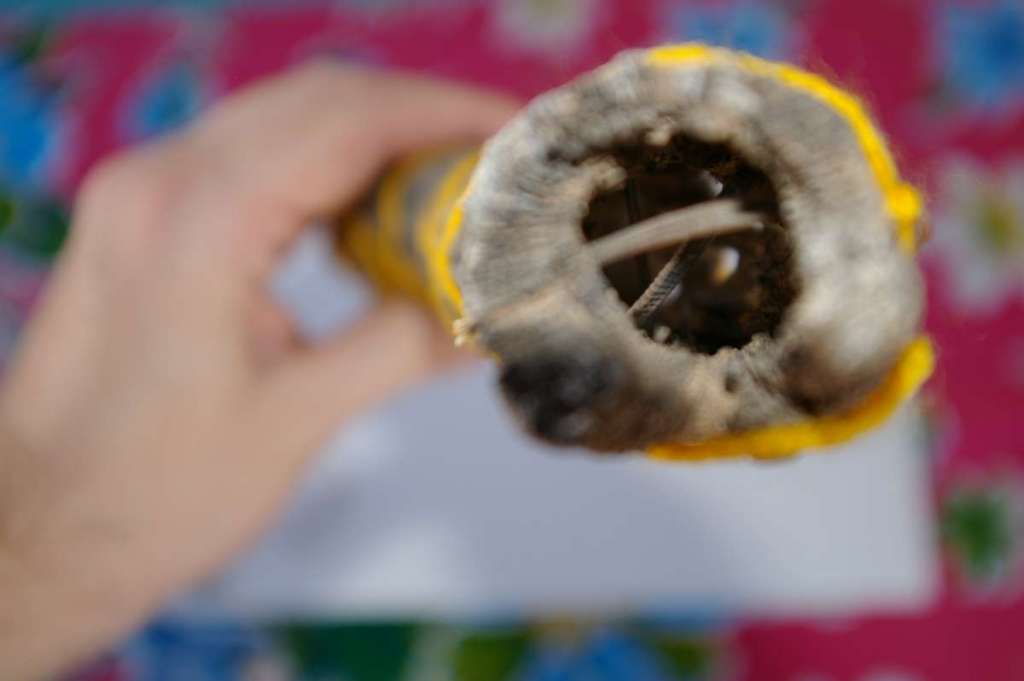
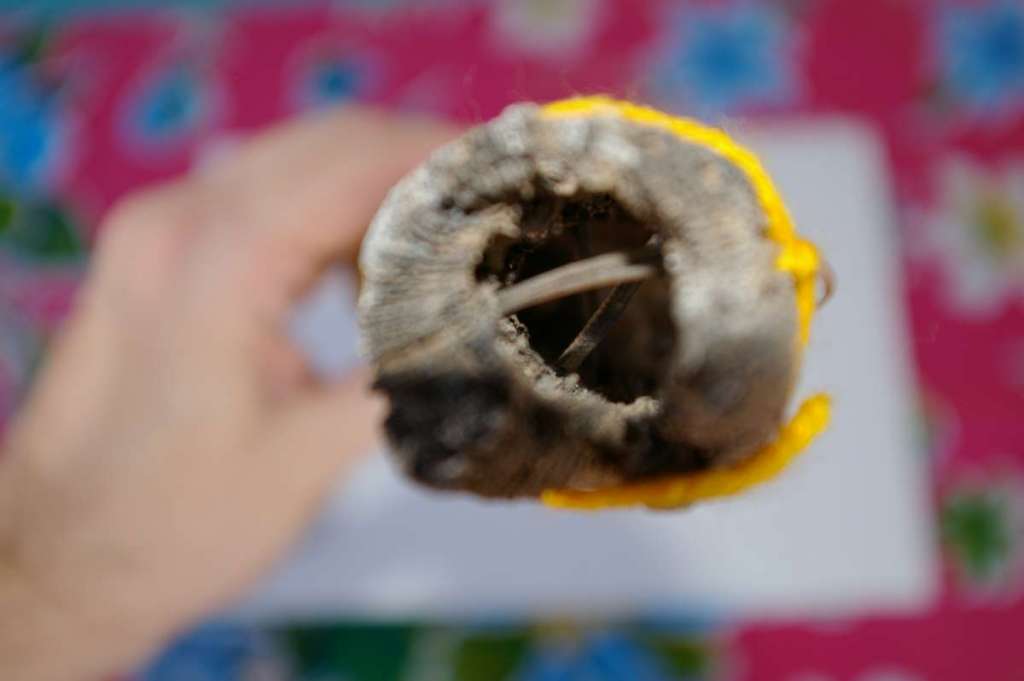


Slide the mesquite pods through the open end. Smaller pods seemed to work better. And tie a cap to the open end.
Next Week’s Theme
